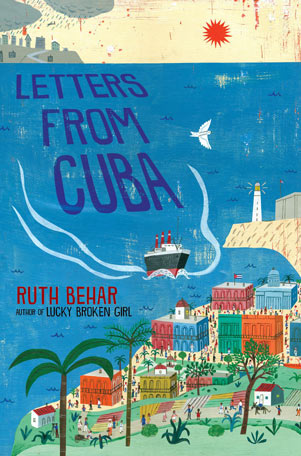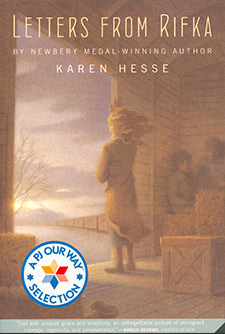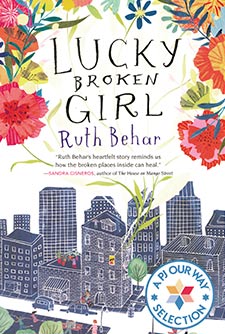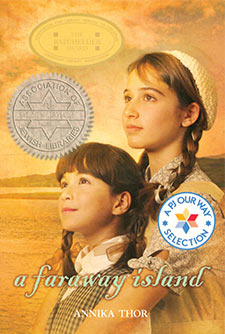Letters from Cuba
Esther and her dad are in Cuba, trying to save up enough for the family in Poland to join them. She really misses them, especially her sister, Malka, but how can a twelve-year-old earn that kind of money?
Average Rating
( hint: Login to leave a review! )
81 Reviews
Leave Review
What the Book Is About
Jewish Content & Values
Positive Role Models
Content Advisory
Talk It Over
More for You
What the Book Is About
Esther’s father has been in Cuba for the past three years, trying and failing to earn enough money to bring the family out of Poland on the eve of the Holocaust. When he is finally able to earn enough money for one ticket, feisty Esther travels across the world to join him. She meets many kind angels along the way and develops close friendships during her journey and later in Cuba. Her friendly approach is reciprocated; her new friends introduce her to various new cultures, and she shares her own. All the while, Esther writes, diary style, to her beloved sister Malka about her experiences. While helping her father peddle various wares, Esther stumbles upon a way that she can help reunite her family. This is a beautiful and inspiring story of immigration, friendship, and community.
Jewish Content & Values
- Esther and her father celebrate the Jewish holidays of Passover, Rosh Hashanah and Hanukkah along with their Chinese, Afro-Cuban, and Christian neighbors. Their multicultural seder includes thoughtful historical and personal references to Jewish slavery in Egypt as well as Black and Chinese slavery.
- Esther and her father observe Yom Kippur in Havana, where they connect with the Cuban Jewish community through prayer and an Ashkenazi-style break-fast.
- Señor Eduardo is a pro-Nazi antisemite. The Agramonte community unites to protect Esther and her father against his venom.
Positive Role Models
Esther is hard-working, resourceful, and loving. She embraces the people of Agramonte even though their religion and traditions are different from her own, and she works night and day at her sewing machine to help reunite her family.
Content Advisory
Señor Eduardo bullies Esther’s father and voices abhorrent views about Jewish people. Kristallnacht, discrimination against Jews in Eastern Europe, and the horrors of Black slavery are all introduced in an age-appropriate manner without graphic detail.
Talk It Over
Everyone in Agramonte calls Esther “La Polaquita,” the Polish girl. She tells her new friend, Francisco: “In Poland, I wasn’t even considered Polish. I was just a Jew. I had to come to Cuba to become Polish.” What do you think about Esther’s Cuban nickname? Has anyone ever called you by a nickname that made you feel different?
More for You
Many believe that the Cuban Jewish community was founded by Conversos who fled to avoid the Inquisition after the expulsion from Spain in 1492. Before Castro’s Cuban Revolution, more than 12,000 Jews lived in Cuba, but 95% of the community emigrated immediately afterwards to the US or Israel. In the early 1990s, Operation Cigar was launched. Supported by the Jewish Agency, it secretly brought over 400 Jews to Israel over a five-year span.
What the Book Is About
What the Book Is About
Esther’s father has been in Cuba for the past three years, trying and failing to earn enough money to bring the family out of Poland on the eve of the Holocaust. When he is finally able to earn enough money for one ticket, feisty Esther travels across the world to join him. She meets many kind angels along the way and develops close friendships during her journey and later in Cuba. Her friendly approach is reciprocated; her new friends introduce her to various new cultures, and she shares her own. All the while, Esther writes, diary style, to her beloved sister Malka about her experiences. While helping her father peddle various wares, Esther stumbles upon a way that she can help reunite her family. This is a beautiful and inspiring story of immigration, friendship, and community.
Jewish Content & Values
Jewish Content & Values
- Esther and her father celebrate the Jewish holidays of Passover, Rosh Hashanah and Hanukkah along with their Chinese, Afro-Cuban, and Christian neighbors. Their multicultural seder includes thoughtful historical and personal references to Jewish slavery in Egypt as well as Black and Chinese slavery.
- Esther and her father observe Yom Kippur in Havana, where they connect with the Cuban Jewish community through prayer and an Ashkenazi-style break-fast.
- Señor Eduardo is a pro-Nazi antisemite. The Agramonte community unites to protect Esther and her father against his venom.
Positive Role Models
Positive Role Models
Esther is hard-working, resourceful, and loving. She embraces the people of Agramonte even though their religion and traditions are different from her own, and she works night and day at her sewing machine to help reunite her family.
Content Advisory
Content Advisory
Señor Eduardo bullies Esther’s father and voices abhorrent views about Jewish people. Kristallnacht, discrimination against Jews in Eastern Europe, and the horrors of Black slavery are all introduced in an age-appropriate manner without graphic detail.
Talk It Over
Talk It Over
Everyone in Agramonte calls Esther “La Polaquita,” the Polish girl. She tells her new friend, Francisco: “In Poland, I wasn’t even considered Polish. I was just a Jew. I had to come to Cuba to become Polish.” What do you think about Esther’s Cuban nickname? Has anyone ever called you by a nickname that made you feel different?
More for You
More for You
Many believe that the Cuban Jewish community was founded by Conversos who fled to avoid the Inquisition after the expulsion from Spain in 1492. Before Castro’s Cuban Revolution, more than 12,000 Jews lived in Cuba, but 95% of the community emigrated immediately afterwards to the US or Israel. In the early 1990s, Operation Cigar was launched. Supported by the Jewish Agency, it secretly brought over 400 Jews to Israel over a five-year span.




